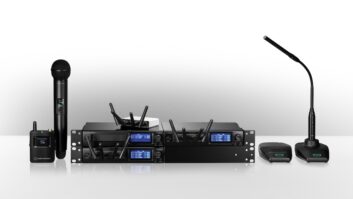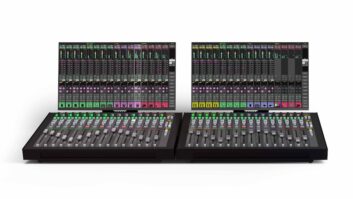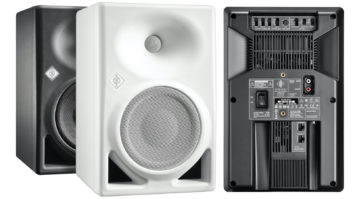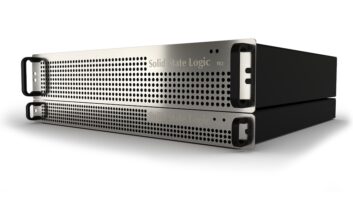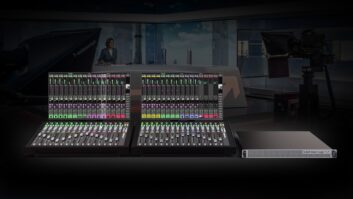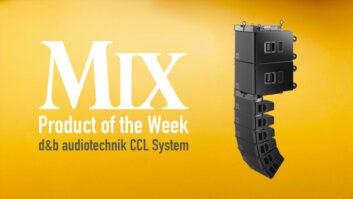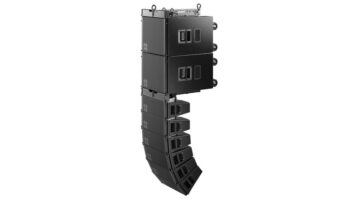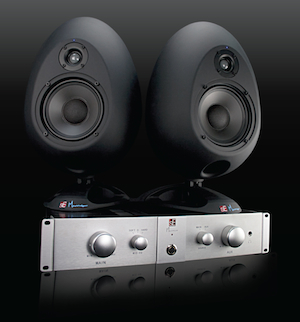
Andy Munro is known to most of us as one of the top acousticians in the field of studio design, with some seriously heavyweight clients to his name including Air Studios, the BBC, Coldplay, Massive Attack, Metropolis Studios, Sphere Studios and U2. Studio monitors and the design of a top-flight recording facility go hand in hand, and Munro had already been involved with the main monitor design for various high-end studios with models like the M4, C4 and 3 and the THX-approved M3F. The development of a near-field speaker was bound to happen at some point.
Designed by Munro in conjunction with the sE Electronics team, the Eggs were introduced at AES nearly 18 months ago. They feature monocoque shell construction, which promises a smooth frequency response and no internal standing waves. Because of the shape, it was necessary to provide control and amplification externally (4x 50W), which is tethered to the speakers with included 9-foot matched cables. Other features include LED locator guide beams for accurate placement, trim pots for LF and HF calibration, and mid-frequency EQ.
The Shapes of Things
In general we’re all used to fairly rectangular boxes when it comes to our speakers. All of the studio standards—the classic Genelecs, NS-10s, Auratones and many others—are straight enclosures with varying degrees of clever design features to reduce the internal resonances. The Eggs are certainly unique and come with a slick, two-unit rackspace amp. You have the option to attach the rack ears to the amp or you can just free stand it somewhere nearby. Installation couldn’t be simpler; roughly put the monitors in their positions, hook them up with the very chunky and high-quality Speakon cables that come with the Eggs, input your console or DAW output signal into the amp, and you’re good to go.
Have a nose around the back of the amp and locate the LED switch. This will activate two bright blue LEDs above both tweeters. Put yourself in the listening position at your desk and make sure you can see both LEDs at their brightest. If you want to tilt the Eggs forward or back a little, you can do that by loosening the swivel nut on the base. I found this cumbersome on my own, so a little help from a friend will come in handy and will save you from having to get up for every millimeter tweak.
I have noticed some engineers like the blue LEDs to be on all the time, but obviously you can disengage them at the back of the amp. Maybe it’s a force of habit now to see a light on an active speaker. We had to go through this process a couple of times as we recorded in various studios. It gets easier, I can assure you.
The amp/control unit is as straightforward as they come. The rear panel holds the inputs on balanced XLRs and the outputs on Speakon. You have an additional aux input on phono, as well. Two trim controls allow you to adjust the HF and LF to deal with room and location acoustical effects at 10 kHz and 63 Hz, respectively. The unit also gives you the option to run it on +4 or -10 dB.
On the front are the power switch, the main volume, the aux volume, main and aux toggle, headphone socket and an EQ control. The EQ is a very subtle ±1.5dB boost centered around 2 kHz, providing you with the option to have a closer look at those frequencies when you’re mixing. Obviously it is suggested to keep your speakers flat to start.
Into the Studio
Elliott Randall (of Steely Dan fame) and I were set to start working on his new album. We mix as we record, and this gave me the chance to put the Eggs though their paces on various tracking and mix sessions, as well as hear them in a handful of different studios.
I initially set up the Eggs in Elliott’s studio where he runs a couple of baby near-fields and a sub. Upon first listen we were both less than impressed. Keeping in mind that engineers and producers are creatures of habit and tend to be highly opinionated, I was expecting something a tad more mind-blowing. The word on the street was and is that these new speakers are going to be the new standard for referencing; maybe I anticipated a little too much.
The first listen gave us a brilliant and ultra-clean high end, a well-defined bottom end—but something was off in the left-right balance. Worried that we were kidding ourselves, I took the Eggs to my studio and set them up there to double-check. Having experienced the same results, we decided to send the units back for sE to check. They sent us a new set of speakers and a new amp and we were up and running with equal level on both sides.
Set up with our fresh pair of Eggs it became immediately clear that this is not just another set of near-fields. I’ve already mentioned the crystal-clear top end; however, the main thing that makes these speakers very special indeed is the stereo imaging they provide. I found myself panning a lot wider without having that feeling that I had gone too far. The Eggs maintain a very solid center image and give you a detailed stereo plane that translates on domestic and car systems.
The amazing high-end clarity the Eggs deliver helped us a lot when it came time to mix the song “Later Last Night” on Elliott Randall’s new Virtual Memory album. When you’re mixing, you definitely want a set of speakers on hand that’s going to be brutally honest and tell you where the problems are. The Eggs allowed us to focus on the crispness of the cymbals and dial out some of the harshness that can excite some home systems in a bad way.
They also allowed me to put the magnifying glass on the top end of the Leslie speaker, look at the bite of the guitars, and make sure the flanger on one bar across the entire mix was singing enough. They also zoomed in on some bass string noises, so I could repair those little inaccuracies. I know I keep talking about the Eggs’ brilliant HF, but it is their strong point. These monitors give you such a clear image of the drum transients—they really punch through. Even though there are no vocals on this particular record, we referenced a lot of varying material on the Eggs to familiarize ourselves with their sound. Thinking back to the NS-10 days, the vocals pop out in the mix nicely, so you can flip back and forth between your main monitors and the Eggs to keep an eye on overall vocal levels and fader moves.
On the low end, I did find myself wanting to push the bass quite a bit. Once we checked the mix on several other studio monitors and domestic systems, it became clear that the bass increase was not necessary. Once again, this is an area to keep an eye (or ear, rather) on.
We had the Eggs for a good stretch of time and like with any speaker, you need to get used to them. You learn their quirks, and your ears simply need to adjust to all these new characteristics you’re hearing. The Munro/sE Eggs became really valuable tools during mixing. Switching back and forth between your regular near-fields and the Eggs gives you a much clearer picture of the panning in your mix, and because the Eggs appear to be quite bright in the upper mid-range, you don’t overexcite those frequencies and end up with ultra-harsh mixes. The only thing I would say about the low end is that, for me, it’s a little soft. It’s worth keeping that in mind, and don’t overemphasize those frequencies.
The Outcome
The Eggs are a set of great speakers. They look different and quirky, and it’s about time somebody had the guts to come up with a completely new speaker design and make it work. A lot of positive and constructive feedback has gone back to Munro, and I wouldn’t be surprised if a few useful tweaks are on the way. Munro has also informed us that Baby Eggs and Big Daddy Eggs are in the pipeline. And for those of us who really like to get the pants flapping, there’s a kick-ass sub in the making!
Time to throw some Eggs into the mix. Get in touch with sE and organize a demo pair to be sent out to your studio.
Wes Maebe is a UK-based recording, mixing, mastering and live-sound engineer. Check out his work at www.wesonator.co.uk.
PRODUCT SUMMARY
Company: Munro/sE Electronics
Product: Egg 150 monitor system
Price: $2,499
Pros: Great stereo imaging. Light and easy to transport. Front-ported.
Cons: Setup can be done on your own but is really a two-man job. EQ is too subtle. Soft low end.
TRY THIS
Originally I set the Eggs up on my desktop. After spending a little more time with them, we discovered that they sounded much better on top of my main near-fields, angled down. It’s worth testing the speakers out in a couple of places in the control room to hear where they interact best with your acoustical environment.
